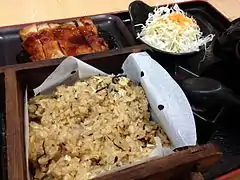 Okowa bento | |
| Alternative names | おこわ (強飯) |
|---|---|
| Type | steamed rice dish |
| Place of origin | Japan |
| Associated cuisine | Japanese |
| Serving temperature | Room Temperature |
| Main ingredients | rice, meat or vegetables |
| Ingredients generally used | wild herbs (sansai okowa) and vessel chestnuts (kuri okowa) |
| Variations | Sekihan or Kowameshi |
Okowa おこわ (強飯) is a Japanese steamed rice dish made with glutinous rice mixed with meat or vegetables.[1] It is sometimes combined with wild herbs (sansai okowa) and vessel chestnuts (kuri okowa).[2] It is generally boiled glutinous rice blended with Azuki beans to give it red color for festive look, made by boiling regular rice with Azuki beans.[3][4] Since Okowa is meant to be eaten at room temperature, it is used to make onigiri for its capacity to be frozen well.
Etymology
The word Okowa in Japanese stems from a shortened form of Kowameshi (meaning "hard rice"). Sometimes, dishes made by blending different rice varieties is also known as Okowa.[4]
History
Originally referred to plain glutinous rice made in steam, Okowa today refers to red rice called Sekihan. White steamed rice is called by another name.[5]
Variations
Okowa can be mixed with any kind of meat or vegetable composition, kept with the basic rice and different flavors. Some traditional accompaniments, include, sweet potato, chestnuts (pre-cooked), bamboo shoot (boiled). Char siu pork, roasted duck or diced sausage are also common additions. Other methods of cooking rice, includes, the kayu, the dango, the ojiya, the mochi, and the sushi.[6]
Method to prepare Okowa Riceballs
The ingredients used for making Okowa riceballs include Glutinous rice (short-grain), sesame oil, dashi, soy sauce, mirin, salt, ginger, chopped mushrooms and carrots, sweet potato, chestnuts, spring onions, cooked fish, and a sheet of nori.[7] The rice is washed with water and is left to be drained for around thirty minutes. Rice is added along with the stock, mirin, sesame oil, salt, sake in a rice cooker, and it is left for another thirty minutes. Meat, vegetables, and ginger are added next, and the cooker is put to the short-grain rice setting. The lid is covered while using the saucepan and brought to the boil once before turning the flame to low for another twelve minutes. The flame is turned off, and the rice is steamed another for ten minutes. The rice is kept in the room temperature and shaped into small triangles or balls. Finally, the base of rice balls is wrapped with nori sheet.[7][8]
See also
References
- ↑ "Food and Wine Festivals and Events Around the World", C. Michael Hall, Liz Sharples, ISBN 1136402691
- ↑ A Taste of Japan, Donald Richie, Kodansha, 2001, ISBN 4-7700-1707-3
- ↑ "History of Soybeans and Soyfoods in Japan, and in Japanese Cookbooks and Restaurants outside Japan (701 CE to 2014)", William Shurtleff, Akiko Aoyagi ISBN 9781928914655
- 1 2 "Kibo ("Brimming with Hope"): Recipes and Stories from Japan's Tohoku", Elizabeth Andoh, ISBN 9781607743705
- ↑ Japanese Cooking: A Simple Art Cookery, Food and Drink Series", Shizuo Tsuji, ISBN 9784770030498
- ↑ "Transactions of the Congress". 1925.
- 1 2 Daoust, Phil; Khaleeli, Homa; Sawa, Dale Berning; Cacanas, Zoe (22 April 2017). "Four recipes to get your kids eating more veg and less sugar - Cooking with kids". the Guardian. Retrieved 6 November 2018.
- ↑ Itoh, Makiko (14 October 2016). "'Kuri': The nutty staple of ancient Japan". Retrieved 6 November 2018 – via Japan Times Online.